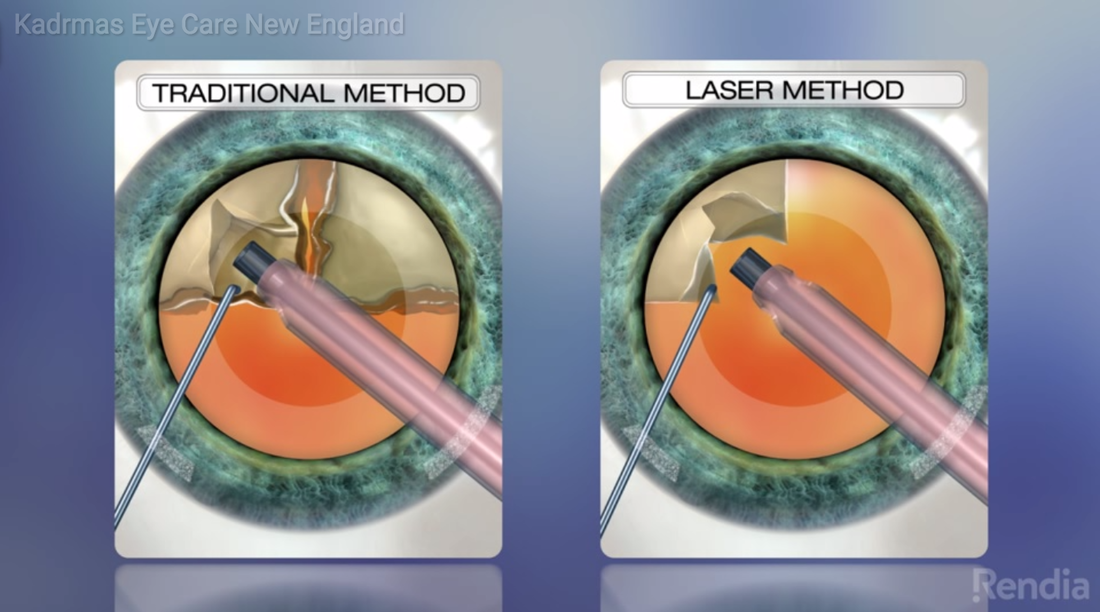Traditional and All-Laser Cataract Surgery Side-by-Side
The primary differences between traditional cataract surgery and all-laser cataract surgery are ocular (eye) imaging and the steps that are performed manually by the cataract surgeon and the steps that are performed automatically or assisted by the laser. Here is a side-by-side comparison of the steps involved in the two surgical procedures:
* Learn more about IOL options in our upcoming blog posts on vision after cataract surgery and choosing the right IOL for you. Pre-Operation, The Procedure, Post-Operation, and Outcomes
Pre-operation, the procedure, post-operation, and outcomes are much the same for both traditional cataract surgery and all-laser cataract surgery.
Pre-Op On the day of your surgery, you will arrive at the surgery center about one hour before your scheduled surgery time. Our nurses will greet you, prepare you for IV sedation, and make sure you are comfortable and relaxed. You will then be taken into the operating room, where dilating and anesthetic drops will be placed in your eyes to enable the surgery to be performed with minimal, if any, discomfort during the procedure. The Procedure During cataract surgery, you will lie on your back and look at a bright light. The operation lasts only about 10 minutes and will vary slightly depending upon whether you and your cataract surgeon have elected traditional or all-laser cataract surgery. However, in either case, the incisions in your eye will not require stitches after the artificial replacement lens (IOL) has been placed. Your eye’s natural pressure will reseal the incisions. With IV sedation and anesthetic eye drops, most patients do not feel discomfort or even remember much of the surgery, whether you have tradition or all-laser cataract surgery. Post-Op Cataract surgery is performed on an outpatient basis, meaning you will be allowed to go home after the procedure the same day. You will need to wear an eye patch and avoid heaving lifting for one week to protect your eye. You will also use postoperative eye drops to avoid inflammation and infection in your eye. Outcomes According to a survey by the American Society of Cataract and Refractive Surgery (ASCRS), more than 98% of cataract patients reported that their vision improved after cataract surgery. For many cataract patients, they may actually experience better vision than before they developed cataracts. These outcomes are made possible by advancements by artificial lens replacements (IOLs), which we will discuss in our next two posts. Cataract Surgery Consultation
At Kadrmas Eye Care New England, we have two highly skilled and experienced cataract surgeons who are here to speak with you about your eyes, cataracts, your need for treatment, and your surgical and lens implant options:
Please call us at 508-746-8600 to schedule an appointment with Dr. Strecker or Dr. Nielsen. Stay tuned for our following posts in this series to learn about vision after cataract surgery and IOL options. To learn more about cataracts and cataract surgery, please visit our Cataracts webpage, as well as our Cataracts blog posts. Comments are closed.
|
EYE HEALTH BLOGCategories
All
Archives
May 2024
|
|
Kadrmas Eye Care New England
55 Commerce Way, Plymouth, MA 02360
14 Tobey Road, Wareham, MA 02571 133 Falmouth Road (Rt 28), Mashpee, MA 02649 |
Phone Number:
1-508-746-8600 Hours: Monday through Friday — 8 AM – 4:30 PM |


 RSS Feed
RSS Feed
